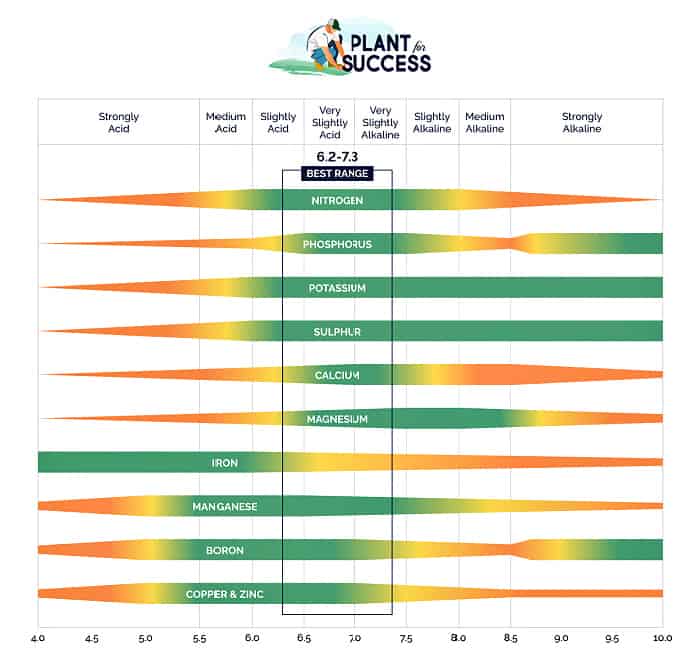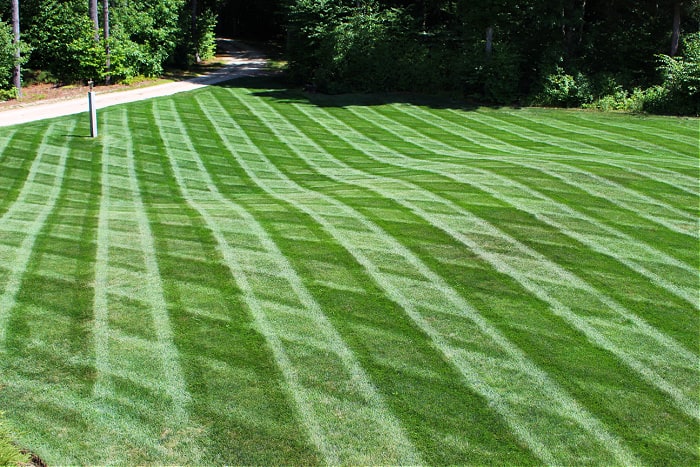If your lawn pH is too high it won’t be able to absorb nutrients from fertilizers. To achieve a Lower Lawn pH you need to use the right products at the right time.
Why Is Lawn pH Important?
Having the correct Lawn pH is one of the most important, and often overlooked steps for homeowners determined to have a healthy lawn. If your lawn pH is too high (meaning to alkaline) or your pH is too low (meaning too acidic) it is harder for your grass to absorb nutrients in the soil. This means you’ll be wasting money, and time, fertilizing your lawn since the grass won’t be able to absorb nutrients. That is why figuring out your lawn’s pH is one of the first steps you have to take before you begin your lawn care program.
Lawn pH Level Chart
Every grass type is different so there is some variation on the preferred pH level depending on the grass species, but in general a pH between 6.0-7.0 is best. Why is this range the best? Take a look at the chart below. You can see that in this range most of the important nutrients can be absorbed. Nitrogen, Phosphorus, Potassium, and Iron are among the most important for overall health and appearance. One thing to point out is as you start to get higher than 6.5, your lawn doesn’t absorb iron as well. It’s one of the reasons why I like to keep my lawn on the more acidic side, since iron helps provide a dark green color.

High pH Lawn Symptoms
For the most part, having too high of a pH in your lawn and having too low of a pH have similar symptoms. You’ll probably notice that fertilizer isn’t positively effecting your lawn. You’ll probably notice a lighter grass blade color and poor stem development. Your lawn might be overall thin, with bare patches.
Causes of High pH in Lawn
The reality is that some soils are more alkaline than others simply because of their make up. A lot of this can be regional since different regions have soils that are made from different minerals and different minerals have different pH levels.
How to Test for pH in Lawn
By far the best thing you can do is to send your soil in for analysis. This used to be a huge inconvenience but with the Yard Mastery Test Kit it is really easy. They mail you a kit, you take a scoop of soil and put it in the included container, and mail it using their included envelope. Soil results are available online quickly, usually within a week. Not only will you get your soils pH but you’ll also get to see the levels of a number of important nutrients. This is the test I use for my lawn twice a year so I highly recommend it. I’ve experimented with pH testers in the past and none have been quite as accurate as mailing in a soil test for analysis.
How to Lower Lawn pH
First off, you need a reality check. Lowering the pH of your lawn is a slow process that can take several months, even years. Depending on how much you need to change your pH it could take several applications of a combination of products. Think of this as amending your soil gradually over time.
Sulfur Products
Applying sulfur to your lawn is one of the best ways to achieve a long lasting decrease in soil pH. It works when the microorganisms in the lawn oxidize the sulfur and turn it into sulfuric acid which lowers your lawns pH. For the oxidation to occur the soil needs to be active so you don’t want to apply to a dormant lawn. Wait until spring and/or early fall to apply.
It takes at least 10 lbs. of sulfur per 1000 s/f to lower your pH by one point. However, it could take much more if your soil is less sandy and more loamy or clay like. You should not exceed 5lbs of sulfur per 1000s/f in a single application or you could damage your lawn. So if you are aiming to lower your pH by one full point, it would take 2 applications (one in spring, one in fall) of 5lbs per 1000 s/f to get a total of 10lbs. per 1000 s/f for the season.
Don’t be intimidated by the math. It is actually really easy. Just start by getting the square footage of your lawn. Once you have the square footage of your lawn, divide that number by 1000. Then, multiply that number by 5 and you have the total amount (in pounds) of product you need to apply to your whole lawn. For example if you have 6,000 s/f of lawn total the math looks like this: 6,000sf / 1,000sf = 6. Then you take 6 and multiply it by 5lbs to get a total of 30lbs. This would be the maximum amount of sulfur you can apply to your lawn in one single application.
One important note is if you are planning on core aerating then time it so that one of your sulfur applications is immediately after core aeration. This will help amend the soil quicker than just having the sulfur rest on the surface of the lawn.
There are 2 great sulfur containing products that should be considered if you want to lower the pH of your lawn:
1. Mag-I-Cal Plus For Lawns in Alkaline and Hard Soils by Johnathan Green
Jonathan Green Mag-I-Cal Plus for Lawns in Alkaline & Hard Soil lowers pH with a combination of sulfur and calcium sulfate dihydrate. This not only lowers soil pH but also helps to reduce compaction, improve root penetration, and releases nutrients trapped in the soil by increasing biological activity. If your pH is above 7 then apply this product twice a year at the suggested label rate. The great part about this product is if doing the math to determine application rates confuses you there’s no need to worry. They did the work for you, simply follow the suggested rates on the label!
2. Southern Ag Pelletized Soil Acidifier
Southern Ag Pelletized Soil Acidifier contains 90% sulfur and 10% Bentonite. The Bentonite improves nutrient holding capacity of soils and helps provide a better environment for soil microorganisms. Use this product when grass is actively growing (not dormant). Apply at a single application rate of 5lbs. per 1000 s/f, up to 2 times a year. The label says you can apply up to 3 times a year, however I would recommend only doing 2 applications and skipping the mid summer application since applications need to be at least 2 months apart, and this is not something you want to apply to a stressed lawn in mid summer.
Ammonium Sulfate 21-0-0
Ammonium sulfate is a white hygroscopic, water soluble fertilizer. Think of Ammonium Sulfate as a fertilizer, rich in nitrogen, that also lowers your soil pH. Ammonium Sulfate typically has 21% nitrogen and 24% Sulfur. Make sure you understand how to fertilize your lawn before applying Ammonium Sulfate 21-0-0 since overapplying can cause your lawn to burn.
There are several Ammonium Sulfate 21-0-0 products out there but one of the best and most available is this product by Greenway Biotech.
If you follow the 1lb of nitrogen per 1000 s/f rule you’ll see that you you can apply about 5lbs of this product. The math looks something like this: 1lb of nitrogen/.21 = 4.8lbs. (the .21 is the percent of nitrogen in the fertilizer bag). Round up to 5 and that means 5 lbs. of this product will give you a nitrogen application rate of 1lb per 1000 s/f. Remember, with fertilizer (especially quick release fertilizers) we don’t want to exceed nitrogen rates of 1lb per 1000 s/f since you risk burning your lawn.
You can apply this product once in the spring, and once again in the fall. Every time you apply it just remember this replaces whatever fertilizer you were going to use for that application. Generally I favor slow release fertilizers as I outline here: Fertilizer Program for Green Grass, but if you’re working on correcting your soil pH then working in 2 applications of Ammonium Sulfate 21-0-0 can help lower your soil pH while also providing you the benefits of a nitrogen fertilizer.
Urea Fertilizers
Urea fertilizers also help to lower soil pH over time, they are not as quick and as powerful as ammonium sulfate fertilizer though. This is a more laid back approach since sulfur and ammonium sulfate will have a greater impact in reducing soil pH, but working urea fertilizers into your lawn program can help make your soil more acidic. Generally, I prefer slow release fertilizers, instead, urea will give you a very quick release of nitrogen. But if you are working to correct soil conditions than using urea fertilizers can be beneficial. Avoid urea fertilizers during the mid summer especially if your lawn is stressed.
Urea Fertilizers are easy to find since they are the most common fertilizers found in the big box stores. Scotts Turfbuilder for example has nitrogen derived from Urea. To see if a fertilizer has urea simply look at the back of the bag where the label is. Under where it says nitrogen, you should see Urea with a percentage. This tells you how much of the nitrogen is derived from Urea.
Once again, when applying fertilizers make sure you don’t overapply since this can destroy your lawn. Stick to 1 lb. of Nitrogen per 1000 s/f.
FAQ
How long does it take to decrease soil pH?
Decreasing soil pH is a slow process that can take several months, even years, depending on how significant of a change you are trying to make, what products you use, and how often you apply those products.
Will Aluminum Sulfate work to decrease soil pH?
Yes, and it will do so quicker than many other methods, however it is the most risky and has the highest chance of damaging your lawn and soil. Over application can actually increase the aluminum concentration in the soil to the point where it becomes toxic to the lawn. For this reason Ammonium Sulfate is a better option.
Are there organic ways to decrease soil pH?
Amending soil with Peat Moss can help decrease soil pH but the effects are temporary. As the Peat Moss breaks down it gets neutralized so the soil acidifying effects wane.
Check Out These Posts Next
Lime Your Lawn: A Complete Guide
How to Measure Square Footage of Your Lawn
Understanding NPK Numbers on Your Fertilizer Label
Top Dressing Lawn: Advice and Benefits
Lawn Care Program for Extra Green Grass
Lawn Care Program for Warm Season Grass (2)
Follow Me
Join my free email list!



The Mag-I-Cal Plus product RAISES pH. Your article states that it LOWERS pH… which is my goal. I discovered this after visiting Amazon to purchase… thankfully the description caught my eye. I was intrigued by both the pH lowering and lessening of soil compaction. What other product would lower pH and lessen soil compaction.
Hi Michael… Read the description again, I have it correct, this one lowers the pH. It’s the purple bag, you might be looking at the black or grey bags. If you’re looking to purchase simply click the link that I have in the post or you can click the purple bag pic that I have in the post. It’ll ship right to your door.
Hi Mark,
Could you touch on the ph level of municipal water used to irrigate a lawn? I’ve been trying to lower my soil ph for a year and my cooperative extension office test result showed an INCREASE. I’ve read that monthly maintenance of citric acid can help mitigate the effects of alkaline water allowing the other soil amendments to have a positive impact, but I just don’t know how to go about it.
Thanks,
Bill
Hi Bill,
Normally I recommend treating the soil using the products described in this post. Changing soil pH can be a long process, especially if your water is very alkaline, but repeat applications should help counteract that. With changing soil pH, it’s very rarely one and done. Also, another option if you want to treat the water directly is to install and acid injection system. A water treatment company can guide you on how they work, but that will take care of the source of your problem if you’re willing to go with this more expensive option.